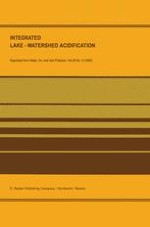1985 | OriginalPaper | Buchkapitel
The ILWAS Model: Formulation and Application
verfasst von : Steven A. Gherini, Lingfung Mok, Robert J. M. Hudson, George F. Davis, Carl W. Chen, Robert A. Goldstein
Erschienen in: Integrated Lake-Watershed Acidification
Verlag: Springer Netherlands
Enthalten in: Professional Book Archive
Aktivieren Sie unsere intelligente Suche, um passende Fachinhalte oder Patente zu finden.
Wählen Sie Textabschnitte aus um mit Künstlicher Intelligenz passenden Patente zu finden. powered by
Markieren Sie Textabschnitte, um KI-gestützt weitere passende Inhalte zu finden. powered by
The Integrated Lake-Watershed Acidification Study (ILWAS) model was developed to predict changes in surface water acidity given changes in the acidity of precipitation and dry deposition. The model routes precipitation through the forest canopy, soil horizons, streams and lakes using mass balance concepts and equations which relate flow to hydraulic gradients. The physical-chemical processes which change the acid-base characteristics of the water are simulated by rate (kinetic) and equilibrium expressions and include mass transfers between gas, liquid and solid phases. The aqueous constituents simulated include: pH, alkalinity, the major cations (Ca2+, Mg2+, K+, Na+, and NH4+) and anions (SO42-, NO3-, Cl-, F-), monomeric Al and its inorganic and organic complexes, organic acid analogues and dissolved inorganic carbon (CT). Since free hydrogen ion (H+) (and hence pH) is not conserved, its concentration is derived from the solution alkalinity and the total concentrations of inorganic C, organic acid, and monomeric Al.The ILWAS model has been used to predict changes in the acidity of Woods Lake (typical lake pH 4.5 to 5.0) and Panther Lake (typical lake pH 6 to 7) given reductions in total atmospheric S loads. The two basins are located within 30 km of each other in the Adirondack Mountains and receive similar acidic deposition. The response to a halving in the total atmospheric S load was basin-specific: In Panther Lake, little pH change occurred even 12 yr after the load reduction; in Woods Lake, the change was considerably larger.Hypothesis testing with the model has shown that the routing of water through soils (shallow versus deep flow) largely determines the extent to which incident precipitation is neutralized. Analysis of the two lake basins using the model and field data showed the watersheds to be net suppliers of base to the through-flowing water, although internal watershed production of strong acidity did occur. This internal production of acidity was approximately two-thirds the amount of the atmospheric load.
